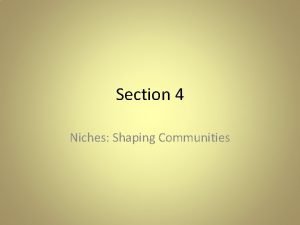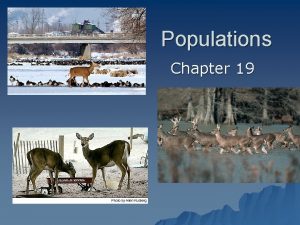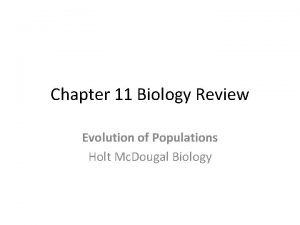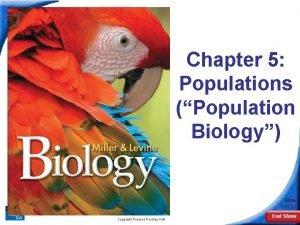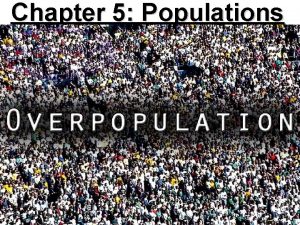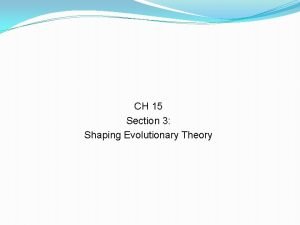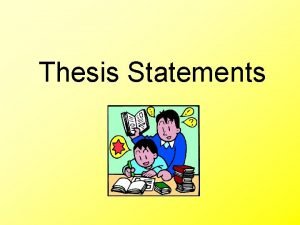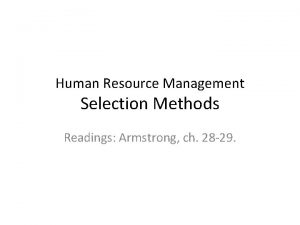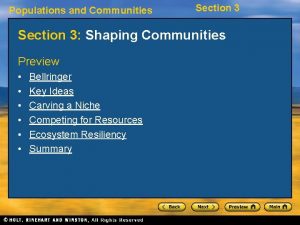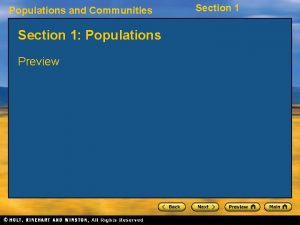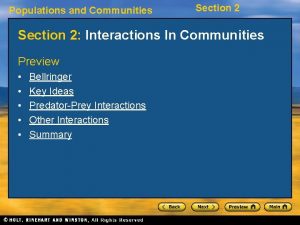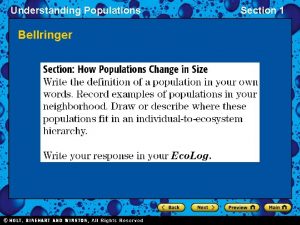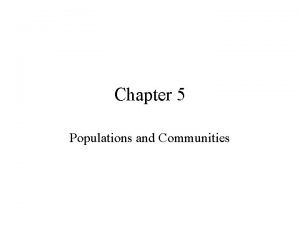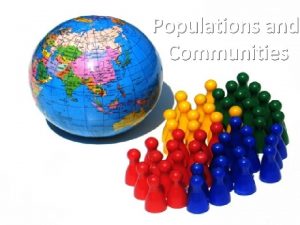Populations and Communities Section 3 Shaping Communities Preview














- Slides: 14

Populations and Communities Section 3: Shaping Communities Preview • • • Key Ideas Carving a Niche Competing for Resources Ecosystem Resiliency Summary

Populations and Communities Section 3 Key Ideas • How does a species’ niche affect other organisms? • How does competition for resources affect species in a community? • What factors influence the resiliency of an ecosystem?

Populations and Communities Section 3 Carving a Niche • Niche – Role an organism plays within the community • A niche is not the same as a habitat. A habitat is the place where an organism lives. • A niche includes the role that the organism plays in the community. This role affects the other organisms in the community.

Populations and Communities Section 3 Competing for Resources • The entire range of conditions where an organism or species could survive is called its fundamental niche. • A species almost never inhabits entire fundamental niche because of competition with other species. • The actual niche that a species occupies in a community is called its realized niche.

Populations and Communities Visual Concept: Niche Section 3

Populations and Communities Section 3 Competing for Resources, continued • Sometimes, competition results in fights between rivals. • Many competitive interactions do not involve direct contests. But when one individual takes a resource, the resource is no longer available for another individual. • Kleptoparasitism – Stealing food from another organism

Populations and Communities Section 3 Competing for Resources, continued • Competition has several possible outcomes. • Sometimes, one species wins, and the other loses. The loser is eliminated from the habitat. • Other times, competitors can survive together in the same habitat. They are able to survive together because they divide the resources.

Populations and Communities Section 3 Competing for Resources, continued • No two species that are too similar can coexist because they are too similar in their needs. One will be slightly better at getting the resources on which they both depend. • The more successful species will dominate the resources. The less successful species will either die off or have to move to another ecosystem. • Eventually, the better competitor will be the only one left. One species eliminating another through competition is called competitive exclusion.

Populations and Communities Warbler Foraging Zones Section 3

Populations and Communities Section 3 Visual Concept: Competition

Populations and Communities Section 3 Ecosystem Resiliency • Ecosystems can be destroyed or damaged by severe weather, humans, or introduced species. Other factors can help keep an ecosystem stable. • Higher biodiversity often helps make an ecosystem more resilient.

Populations and Communities Section 3 Visual Concept: Biodiversity

Populations and Communities Section 3 Ecosystem Resiliency, continued • Predation can reduce the effects of competition among species. • Predators can influence more than their prey. When predators eat one species, they may reduce competition among other species. • A keystone species is a species that is critical to an ecosystem because the species affects the survival and number of many other species in its community.

Populations and Communities Section 3 Summary • A niche includes the role that the organism plays in the community. This role affects the other organisms in the community. • Competition for resources between species shapes a species’ fundamental niche. • Interactions between organisms and the number of species in an ecosystem add to the stability of an ecosystem.
 Describe the role competition plays in shaping communities.
Describe the role competition plays in shaping communities. Evolution of populations section 16-1 genes and variation
Evolution of populations section 16-1 genes and variation Evolution of populations section 16-1 genes and variation
Evolution of populations section 16-1 genes and variation Hydrarch and xerarch succession
Hydrarch and xerarch succession Section 19-1 review understanding populations
Section 19-1 review understanding populations Whats a density dependent factor
Whats a density dependent factor Evolution of populations section 11 review
Evolution of populations section 11 review 5-1 how populations grow
5-1 how populations grow Section 5-1 how populations grow
Section 5-1 how populations grow Shaping evolutionary theory
Shaping evolutionary theory Chapter 15 section 3 shaping evolutionary theory
Chapter 15 section 3 shaping evolutionary theory Thesis statement sample
Thesis statement sample Thesis and preview statement example
Thesis and preview statement example What is a preview statement
What is a preview statement Realistic job preview advantages and disadvantages
Realistic job preview advantages and disadvantages
